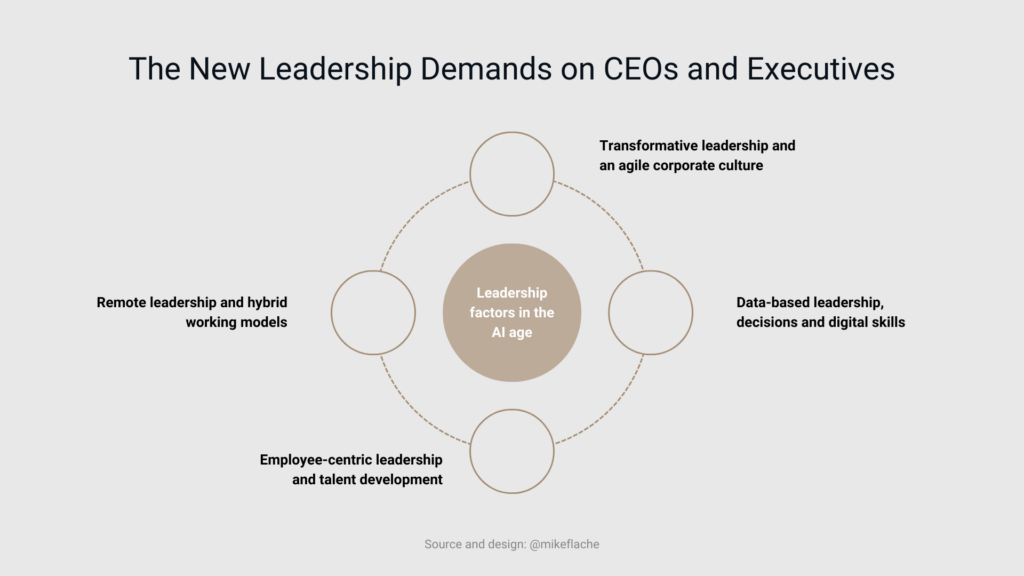Key Takeaways
- Embrace transformative and agile leadership: Leadership 4.0 requires a move away from traditional, hierarchical management towards a transformative, agile style that promotes collaboration, innovation, and personal responsibility. This adaptability is crucial in responding quickly to technological changes and market dynamics, which are increasingly driven by AI.
- Prioritize data-driven decision-making: Effective leadership depends on leveraging data insights to guide strategic and operational decisions in the age of artificial intelligence. CEOs need not only digital tools but also a culture open to data-driven thinking, as data-based decisions have become central to competitive advantage.
- Focus on talent development and flexibility: Leadership 4.0 requires an employee-centered approach emphasizing continuous skill development and a flexible working environment. Investing in talent through upskilling and fostering a hybrid or remote-friendly culture can enhance loyalty, engagement, and productivity in a digitally transformed organization.
In an increasingly digitalized world, leaders’ roles are changing fundamentally. Where hierarchies and traditional structures once dominated, agility, flexibility, and an affinity for technology are now required.
I believe the leadership style must also keep pace with these changes to meet the new requirements and fully exploit the potential of digital transformation in the AI age.
Leadership 4.0 stands for a new paradigm of corporate management in which CEOs and C-level executives act as visionaries, promoters of innovation, and role models for change.
In today’s edition of CEO Insight, we take a closer look at the key factors for successful leadership in the digital age. I also provide practical suggestions on how leaders can make their organization future-proof.
The new demands on CEOs and executives
Digital transformation means more than introducing new technologies – it fundamentally changes how companies are managed and decisions are made.
CEOs and executives face different challenges – from understanding and evaluating digital innovations to developing new business models to enabling their teams to keep pace with the changes.
A study by the World Economic Forum shows that 54% of employees in all industries will need to be retrained or upskilled by 2025 to meet the new requirements1.
This means CEOs need to focus on leading hybrid teams and integrating digital capabilities into the company culture.

Transformative leadership and an agile corporate culture
One of the most crucial changes in Leadership 4.0 is the transition from a classic leadership culture to a transformative leadership style.
Transformative leadership aims to develop the potential of employees and create a vision that becomes a common goal. It is about building trust and giving employees the freedom to take on personal responsibility. In my experience, this is particularly difficult for leaders from traditional corporate cultures.
CEOs must promote a culture based on collaboration, openness, and innovation. According to a study by McKinsey, an agile corporate culture increases the ability to innovate by up to 30%2.
An agile leadership style enables the workforce to respond more quickly to market changes and new customer needs. This is particularly essential for digital transformation in the AI age, as technological change is progressing rapidly, and market conditions are often difficult to predict. Agility and flexibility become a competitive advantage.
Data-based decisions and digital skills
Data-driven decisions play a critical role in digital leadership. CEOs and executives must learn to leverage data-driven insights to make strategic decisions and optimize operational processes.
However, this requires not only new technologies but also a new mindset: the willingness to integrate insights from data analysis and artificial intelligence into decisions.
A practical example is Amazon. The company uses data-based processes and algorithms to optimize the supply chain and continuously improve the customer experience. According to a study by Deloitte, 49% of leaders stated that data-based decision-making processes are crucial to company success in the digital age3.
That means CEOs and executives need IT knowledge, data skills, and the ability to promote a data-based culture in the company.
Employee-centric leadership and talent development
Another core aspect of Leadership 4.0 is the development and retention of talent. The best digital strategies and technologies are only as good as the teams implementing them. Therefore, it is a prerequisite that CEOs and executives take an employee-centric leadership approach and promote a solid learning and development culture.
Especially with digital transformation, it is crucial that leaders continuously develop the skills of their teams. According to a LinkedIn survey, 94% of employees feel more loyal to their employer when it invests in their professional development4.
CEOs should provide programs and resources geared towards digital and soft skills such as creativity, communication, and adaptability.
Remote leadership and hybrid working models
The pandemic has changed the world of work for good and made remote work the new normal. For leaders, this means that they have to lead their teams partially or completely remotely.
To maintain productivity and employee satisfaction, remote leadership requires a high level of trust and clear communication structures.
It is essential to create a flexible corporate culture so employees can work independently and from anywhere. Studies show 83% of employees prefer flexible working models5.
Their ability to use virtual meetings, digital collaboration tools, and asynchronous working methods effectively is a core competency of modern CEOs and executives. They must also ensure that physical distance does not create cultural or emotional distance from employees.
Conclusion
The change to leadership 4.0 presents CEOs and executives with main challenges but also offers opportunities to shape corporate culture and business strategy in a future-proof manner.
Digital transformation in the AI age requires new skills, a rethinking of leadership issues, and the willingness to learn and adapt continuously.
In my experience, CEOs and executives who combine agility and data-driven decisions with an employee-centered and innovative leadership culture will be successful.
The path to successful leadership 4.0 begins with small but consistent steps
Leaders should ask themselves: What digital skills do we need? How do we promote an agile corporate culture? And how do we remain approachable to our employees despite the technical distance?
Anyone who has the courage to answer these questions honestly and implement concrete measures has a good chance of making digital transformation a success factor.
Sources
- World Economic Forum, 2023
- McKinsey & Company, 2022
- Deloitte, 2023
- LinkedIn Learning Report, 2022
- PwC, 2023

